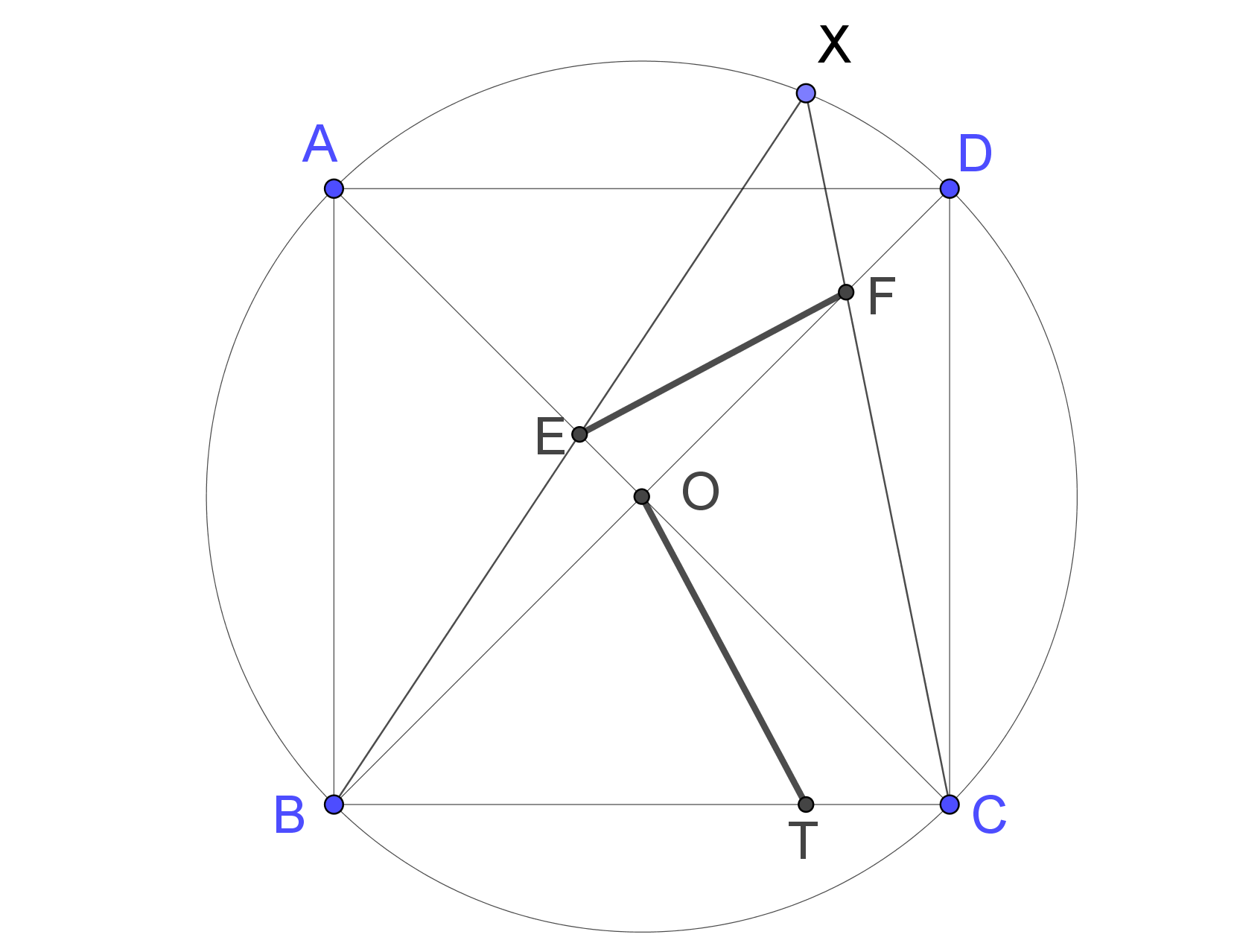 Problem B. 5394. (May 2024)
Problem B. 5394. (May 2024)
B. 5394. Let \(\displaystyle O\) be the center of square \(\displaystyle ABCD\), and let \(\displaystyle X\) be an arbitrary point on its circumcircle. Let \(\displaystyle T\) denote the orthogonal projection of \(\displaystyle X\) onto \(\displaystyle BC\). Let \(\displaystyle E\) denote the intersection of lines \(\displaystyle XB\) and \(\displaystyle AC\), and let \(\displaystyle F\) denote the intersection of lines \(\displaystyle XC\) and \(\displaystyle BD\). Prove the \(\displaystyle EF\) is perpendicular to \(\displaystyle TO\).
(Proposed by Viktor Vígh, Sándorfalva)
(4 pont)
Deadline expired on June 10, 2024.
Sorry, the solution is available only in Hungarian. Google translation
Megoldás.

Legyen \(\displaystyle O\) a koordináta-rendszer origója, jelölje továbbá az \(\displaystyle A\), \(\displaystyle B\), \(\displaystyle C\), \(\displaystyle D\), \(\displaystyle X\), \(\displaystyle E\), \(\displaystyle F\), \(\displaystyle T\) pontok koordinátáit rendre \(\displaystyle (-1;1)\), \(\displaystyle (-1;-1)\), \(\displaystyle (1;-1)\), \(\displaystyle (1;1)\), \(\displaystyle (a;b)\), \(\displaystyle (-e;e)\), \(\displaystyle (f;f)\), \(\displaystyle (a;-1)\). Ekkor
\(\displaystyle \overrightarrow{EX} = (a+e;b-e), \overrightarrow{BE} = (-e+1;e+1). \)
A két vektor párhuzamos, ezért \(\displaystyle \frac{b-e}{a+e} = \frac{e+1}{-e+1}\), így \(\displaystyle e=\frac{b-a}{a+b+2}\).
Hasonlóan, az
\(\displaystyle \overrightarrow{FX} = (a-f;b-f), \overrightarrow{CF} = (f-1;f+1) \)
vektorok párhuzamosak lévén \(\displaystyle \frac{a-f}{b-f} = \frac{f-1}{f+1}\), amiből \(\displaystyle f=\frac{a+b}{-a+b+2}\).
Legyen \(\displaystyle N = (a+b+2)(-a+b+2)\); ekkor
\(\displaystyle f+e = \frac{1}{N}((a+b)(a+b+2) + ((b-a)(-a+b+2)) = \frac{1}{N} (2a^2+2b^2+4b), \)
és
\(\displaystyle f-e = \frac{1}{N}((a+b)(a+b+2) - ((b-a)(-a+b+2)) = \frac{1}{N} (4ab+4a). \)
Mindezek alapján
\(\displaystyle \overrightarrow{EF} = (f+e;f-e) = \frac{1}{N}(2a^2+2b^2+4b;4ab+4a), \)
így az \(\displaystyle \overrightarrow{EF}\) és \(\displaystyle \overrightarrow{OT}\) vektorok skaláris szorzata
\(\displaystyle \frac{1}{N}((2a^2+2b^2+4b)a - (4ab+4a)) = \frac{2a(a^2+b^2-2)}{N}. \)
Mivel \(\displaystyle X\) a négyzet köré írt körön fekszik, \(\displaystyle a^2+b^2 = OX^2 = OA^2 = 2\), vagyis a skaláris szorzat nulla, tehát a két vektor egymásra merőleges.
Statistics:
40 students sent a solution. 4 points: Ali Richárd, Aravin Peter, Bodor Mátyás, Bui Thuy-Trang Nikolett, Christ Miranda Anna, Csonka Illés, Csupor Albert Dezső, Dam Soham, Diaconescu Tashi, Erdélyi Kata, Farkas Ábel, Fehérvári Donát, Fekete Aron, Fórizs Emma, Forrai Boldizsár, Gömze Norken, Holló Martin, Jármai Roland, Keresztély Zsófia, Klement Tamás, Kovács Benedek Noel, Lakner Hanna, Op Den Kelder Ábel, Petrányi Lilla, Pletikoszity Martin, Prohászka Bulcsú, Puppi Barna, Romaniuc Albert-Iulian, Sági Mihály, Sha Jingyuan, Sütő Áron, Tamás Gellért, Török Eszter Júlia, Virág Lénárd Dániel, Virág Tóbiás. 3 points: Vigh 279 Zalán. 1 point: 2 students. 0 point: 2 students.
Problems in Mathematics of KöMaL, May 2024
